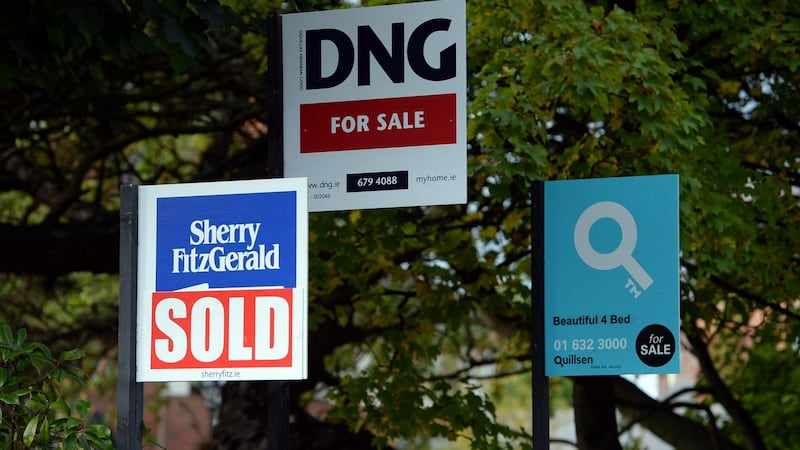Property hunting has become a pastime de jour in the last two years, with pubs and coffee shops the stage for conversations about whether now is the right time to buy, or whether Ireland is in the throes of a property-bubble part two which will leave the market in flames in the not-too-distant future.
One such house-hunter is Michael Doyle, originally from Enniscorthy, Co Wexford, who has been in the market along with his wife Rosanna Kleemann, from Moynalvey, Co Meath, for the last 18 months or so. Doyle works as an analytics manager with Paddy Power in its Belfield HQ, and since a return to Ireland from the UK midway through 2016, has created a computer programme, which he and his partner have used to align their thinking and assist their bidding choices as they look to purchase a first home.
“We came back to Ireland in 2016 and got mortgage approval in the last six months, and started looking properly for a home,” says Doyle who had a budget of up to €650,000 for the right home.
“Myhome.ie and Daft.ie have on average about 27,000 listings on a given day nationally. I created an equation that pulls down every single one of those listings and inputs them into a spreadsheet – essentially.
“The equation takes into account the cost per square metre, which is not readily available. I can then search through these figures to work out what is good value or bad value in a given area, compared to the property-price register, which is readily available to anybody.”
This information can be assessed with regards to “other available public data, such as noise pollution, or proximity to schools or quality bus-corridors” to assess whether a home is good value or not.
Market value
“The equation could look at the market generally, for example, ‘this property is worth X, compared to other property prices in the area’, plus you can then factor in all the other additional facilities of an area,” says Doyle. “Or you could take the equation and tailor it to yourself, for example, saying ‘what is the distance of this property to my workplace? In relation to other properties of similar value.’”

The equation means that Doyle has only bid on select properties over the last few months – three in fact, as he and his wife have specifically targeted only those homes that he feels are of market value to them. The third property they bid on, which met the standards required through his computer programme, the couple have now gone sale agreed on, and are in the final stages of the purchase process.
Having left Enniscorthy after the Leaving Certificate, Doyle studied history and geography at UCD, before a brief stint working as an accountant with his father. He followed that by "moving to Italy for a year and working for the United Nations' food and agriculture department".
Doyle returned to Ireland to study for a master's degree in climate change in Maynooth. "I thought the MA would be more policy orientated, but it turned out to be a bit more numerate, which was actually what I liked" says Doyle. It was during that year that Doyle began to understand and use predictive models that would later inform his data career and subsequent computer programming. Doyle then met Kleeman , and relocated to the UK – where she was about to commence a PhD at the University of Surrey.
"We lived in London, Reading and Guildford for five years and that's where I developed my data-analytics skills, working with IBM, Samsung and Virgin Media, before coming back to Ireland," says Doyle.
House-hunting
At the end of the five years, Doyle and Kleeman quit their jobs and got married in Italy. Post-honeymoon, the couple moved back to Ireland, briefly to Sligo, before they both took jobs in Dublin. A period living with his in-laws followed "in order to save a deposit" before the couple settled in Maynooth, Co Kildare, and began house-hunting in earnest.
“We started viewing with an intent to buy at the start of this year, but we were saving the deposit for a year and a half,” says Doyle. “We had a lot of advantages, including staying with my mother-in-law and not paying any rent as a result. And our parents are also helping us with the deposit.”
Doyle had always hoped his computer programming skills would benefit him when it came time to climb onto the property ladder, and it was midway through 2016 when he cooked up the idea to marry the figures from property websites with the Residential Property Price Register, which lists the prices of all properties sold in Ireland.
“I started writing the programme two years ago, by putting the code together, which has actually helped me in my job, because there are certain skills that I’ve developed through the property equation, which uses a technique called web scraping,” says Doyle.
“All web pages are written in HTML and as part of that HTML there are nuggets of data in there. In this equation the price of the house is listed on the site’s web frame. So, the equation runs through every single page on the property websites, extracting [scraping] every single number, off every single page – a technique I use in my every day job to gain a competitive advantage.”

The technique is similar to systems used by sports clubs to identify transfer targets, by crunching the performance numbers of specific players in other leagues, clubs or academies: a system made famous by Michael Lewis' 2003 non-fiction book Moneyball, which chronicled the Oakland Athletics baseball team's statistical method behind signing players; it was made even more famous by the 2011 film of the same name, starring Brad Pitt and Jonah Hill.
“We use the same technique in Paddy Power or Betfair. Say we have a lot of people betting from one particular market, Italy for example, but we don’t know a lot about that market,” says Doyle. “So, we admin from Dublin, by web scraping the market from Twitter feeds et cetera to find out where people are placing their money.”
Equation
The property-equation computer programme runs daily in scraping the price and square metre size and recording it. Both pieces of data are then divided, from the 27,000 daily figures, to give “a threshold above which the house ceases to become of value”.
Through the equation, Doyle placed a bid on a property on the South Circular Road, Dublin 8, which went beyond a value that was deemed "worth it". Next up was a property in Blackrock, which also went above the indicated value, equated through his computer programme.
For the third property, the listed price was above the indicated value-price produced by the equation, which led Doyle to enter the market and have a final bid accepted that is some €55,000 below the originally listed price – a deal that he believes he only knew was possible as a result of his number-crunching.
Doyle had created a shortlist of “all the properties on the market in the area in question”, based on per sq m value, and was able to identify the home he has gone sale agreed on as the “best-value buy” in the neighbourhood.
One advantage Doyle had was that he was looking for “a property with a price above the most competitive zones”, meaning the number of competitors bidding for the home in question would be far reduced.
One non-factorable element of the equation is when another bidder can drive a bidding war and push the house over the threshold price
“Say you take a three-bed, semi-detached in Harold’s Cross, over 80-90 sq m, you are not getting much bang for your buck, because that area of the market is so competitive,” says Doyle. “The most you’ll get is 100 sq m, for around €450,000 to €500,000. If you compare that with a property double the size, the value is far better. Luckily I can afford that higher [better value] property.”
Bidding war
His computer programme has enabled him to narrow down his search dramatically, solely to properties that meet the criteria of the equation.
One non-factorable element of the equation is when another bidder can drive a bidding war and push the house over the threshold price.
The property Doyle is buying has also been flooded in the past, a factor outside the knowledge of the computer programme. However, through further study of water works in the area, he has deemed that factor an “acceptable risk”.
The equation also “fails to incorporate the potential rental yield of a room, in this case a basement”, which is another human factor that needs to be incorporated into one’s thought process in the buying timeline.
For those without access to his equation, “the property-price register is your best friend”, according to Doyle.
“It’s a golden source and not everybody uses it,” says Doyle. “It’s there, it’s freely available to use. Look at the price trends on specific streets: that’s very easy to do.”











